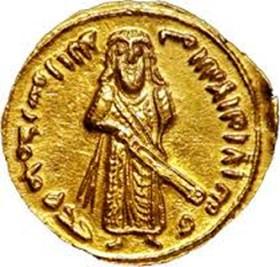The Near East in the Age of Justinian and Muhammad, AD527-700

What were the historical origins of Islam? How did armies loyal to Muhammad and his God manage to destroy the ancient empire of Persia and bring the Eastern Roman Empire of Byzantium to its knees in just twenty years? How did the first Islamic state consolidate its rule over the Near and Middle East by the end of the seventh century? These are among the core questions that students taking this paper will address.
The paper begins with the revival of superpower conflict between the East Roman Empire ruled from Constantinople and the ancient empire of Persia at the start of the sixth century. Initially approaching the Roman-Persian conflict through the eye-witness testimony of the contemporary Greek historian Procopius, students will examine how escalating rivalry led to a struggle for power between the Romans and Persians across the Near East and, crucially, Arabia, where it helped to create the cultural and political pre-conditions for the emergence of Islam, as well as the way in which the two empires reached out to the great nomad powers of Western and Central Eurasia in a desperate attempt to secure imperial superiority and advantage. In the second half of the paper, students focus on the emergence of Islam, consider the lively debate as to the nature of the religion in its formative phase and the role (and historicity) of the Prophet Muhammad, and study how the establishment of Islamic rule ushered in a new epoch in human history the ramifications of which are still with us.
The paper pre-supposes no knowledge of ancient or medieval history, and all original sources are studied in translation. In the past, many students have combined this paper with twentieth-century options, and those who have taken it have found it provides useful preparation for careers in diplomacy, international relations and government service as well as further research in Byzantine and Islamic studies.
The paper will be taught through seven one-on-one supervisions. Students may, if they wish, specialize more on Roman/Byzantine or Islamic topics according to interest, or focus more on the world of pre-Islamic Persia. Students must be comfortable, however, approaching the history of religion from a historical perspective.
A core bibliography of sources available in English translation will be provided and added to as new translations appear, and archaeological evidence will also feature.
Core texts (2023):
Primary Sources in Translation
Procopius, History of the Wars, trans. H.B. Dewing (Loeb Classics, London, 1914–54), Bks. I, II; Bk. VII, 14, 38, 40; Bk. VIII, 1–17 and 25. or in the new edition: ProkopiosThe Wars of Justinian tr. by H.B. Dewing, revised by A. Kaldellis (Cambridge Mass., 2014)
Procopius, The Buildings, trans. H.B. Dewing (Loeb Classics, London, 1954), Bks. I-V.
Procopius The Secret History, trans. H.B. Dewing (Loeb Classics, London, 1935) or in P. Sarris and G. Williams Procopius – The Secret History (London, 2007) or A. Kaldellis, Prokopios – The Secret History With Related Texts (Indianopolis, 2023)
The Acts of the Council of Constantinople of 533 tr. R. Price (Liverpool, 2009)
D. Miller and P. Sarris, The Novels of Justinian – A Complete Annotated English Translation (Cambridge, 2018)
F. Haarer, Justinian – Empire and Society in the Sixth Century (Edinburgh, 2022)
The Apocalypse of Pseudo-Methodius tr. B. Garstad (Washington D.C., 2012)
P. Bell Three Political Voices From the Age of Justinian (Liverpool, 20090
Chronicon Paschale Olympiad 327–end, trans. M. and M. Whitby (Liverpool, 1989).
The Ecclesiastical History of Evagrius Scholasticus tr. M. Whitby (Liverpool, 2000)
The Chronicle of John Bishop of Nikiu, trans. R.H. Charles (London, 1916), chapters 90–123.
The Ecclesiastical History of John of Ephesus, trans. R.P. Smith (Oxford, 1860) Bk. VI.
The Armenian History Attributed to Sebeos, trans. R.W. Thomson, commentary by
J.D. Howard-Johnston (Liverpool, 2000)
Antiochus Strategus Account of the Sack of Jerusalem in A.D. 614 trans. F.C. Conybeare, English Historical Review XXV (1910) pp. 502–17.
Leontius of Neapolis The Life of John the Almsgiver in E. Dawes and N.H. Baynes, Three Byzantine Saints (Oxford, 1948) pp. 195–270.
G. Greatrex and S, Lieu The Roman Eastern Frontier and the Persian Wars – Narrative Sourcebook – Part II AD 363–630 (London, 2002) pp. 62–247.
The Chronicle of Monemvasia trans. P.Charanis, Dumbarton Oaks Papers V (1950), p.148.
Maurice The Strategikon tr. G.T. Dennis (Pennsylvania, 1984)
S. Shoemaker, A Prophet Has Appeared – The Rise of Islam Through Jewish and Christian Eyes (Berkeley, 2021)
The History of Menander the Guardsman tr. R.C. Blockley (Cambridge, 1985)
The History of Theophylact Simocatta tr. M. and M. Whitby (Oxford, 1985)
The History of the Caucasian Albanians te. C. Dowsett (London, 1961)
The Seventh Century in the West Syrian Chronicles tr. A. Palmer and S. Brock (Liverpool, 1993)
Theophilus of Edessa’s Chronicle tr. R. Hoyland (Liverpool, 2011)
The Life of Muhammad: a translation of Ishaq’s Sirat Rasul Allah trans. A. Guillaume (Oxford, 1955), part III.
P.K. Hitti The Origins of the Islamic State, Vol. I (New York, 1916), parts II-IV and part V, chapters 1–2 (i.e. pp. 165–351).
The Koran (various translations available)
Image: So-called ‘standing caliph’ gold coin produced at the end of the seventh century
This material is intended for current students but will be interesting to prospective students. It is indicative only.
